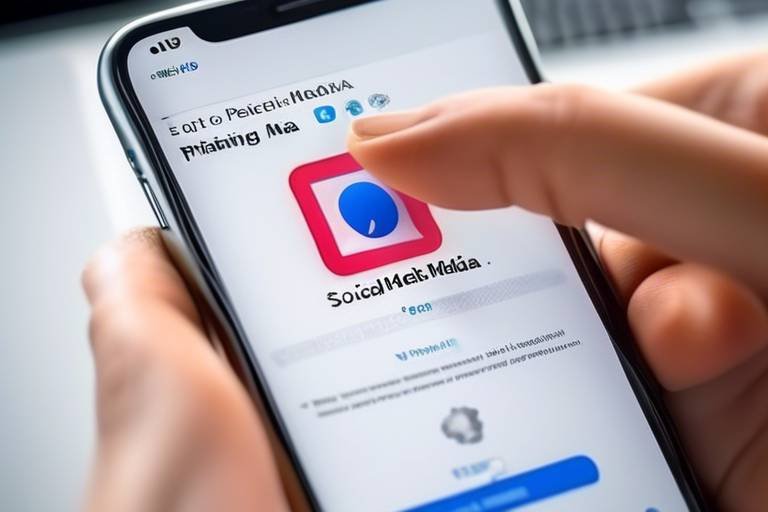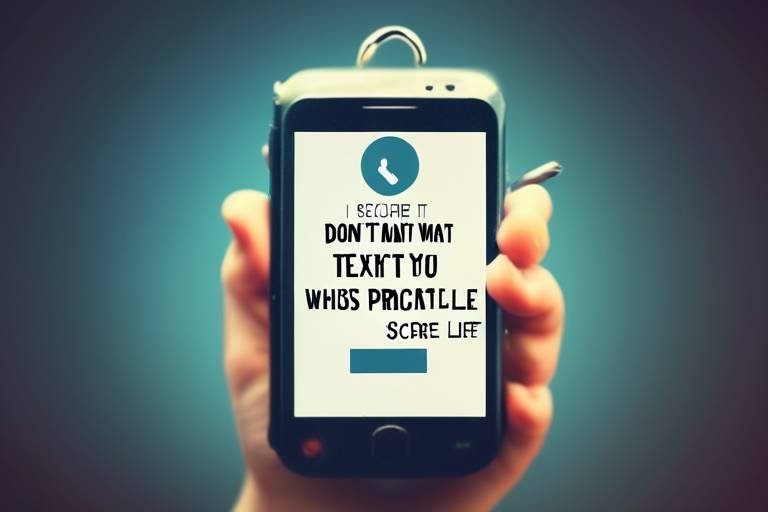Internet Safety - Protecting Your Social Data
In today's digital age, the internet is like a bustling marketplace, full of opportunities but also fraught with dangers lurking in the shadows. As we navigate through social media, online shopping, and various platforms, the importance of protecting your personal information cannot be overstated. Imagine stepping into a crowded room where everyone can see your private conversations and personal details—scary, right? That's exactly what can happen if you don't take the necessary precautions online. This article explores essential strategies and tips for safeguarding your personal information online, ensuring a secure digital experience while navigating social media platforms and the internet at large.
Social data risks encompass various threats, including identity theft, privacy breaches, and data leaks. Recognizing these dangers is crucial for developing effective protection strategies to keep your personal information secure. Every time you share a post, like a photo, or even just scroll through your feed, you're leaving a digital footprint that could be exploited. Think of it like leaving breadcrumbs on a trail; if you're not careful, someone might follow those breadcrumbs right to your door. By understanding the types of risks involved, you can better prepare yourself to defend against them.
Strong password management is vital in protecting your accounts. Utilizing unique, complex passwords and employing password managers can significantly reduce the risk of unauthorized access to your personal data. Just like you wouldn't use the same key for your house and your car, you shouldn't use the same password across multiple sites. A password manager can be your digital vault, generating and storing complex passwords so you don't have to remember them all. This way, you can focus on enjoying your online experience without the nagging worry of being hacked.
Implementing two-factor authentication (2FA) adds an extra layer of security. This method requires a second verification step, making it more challenging for hackers to gain access to your accounts. It's like having a bouncer at the door of your digital life—just because someone has the right password doesn't mean they can get in. With 2FA, even if your password is compromised, the intruder still needs that second piece of information, which can be a text message code or an authentication app notification.
Different 2FA methods, such as SMS codes or authentication apps, offer varying levels of security. Understanding the strengths and weaknesses of each can help you select the best option for your needs. For instance, while SMS codes are convenient, they can be intercepted. On the other hand, authentication apps, like Google Authenticator or Authy, provide a more secure option as they generate codes that are time-sensitive and not easily hackable.
Most social media and online services offer 2FA options. This section provides step-by-step instructions for enabling 2FA on popular platforms like Facebook, Twitter, and Google. Here's a quick overview:
| Platform | Setup Instructions |
|---|---|
| Go to Settings > Security and Login > Use two-factor authentication. | |
| Go to Settings and privacy > Security and account access > Two-factor authentication. | |
| Go to Security > Signing in to Google > 2-Step Verification. |
Phishing scams are prevalent online, targeting unsuspecting users. Learning to identify and report these attempts can help protect your social data from malicious actors. Phishing is like a fisherman casting a wide net, hoping to catch someone off-guard. Whether it's an email that looks like it's from your bank or a message that claims you've won a prize, always be skeptical. Look for signs such as poor grammar, generic greetings, or suspicious links. If it feels off, it probably is!
Adjusting privacy settings on social media platforms is essential for controlling who can access your information. This section discusses the importance of reviewing and customizing these settings for enhanced security. Think of your social media account as your home; you wouldn't leave the front door wide open for anyone to walk in. By tweaking your privacy settings, you can ensure that only trusted friends and family have access to your personal information.
Carefully managing friend requests and followers can prevent unwanted access to your personal data. This section highlights strategies for vetting connections on social media platforms. Always take a moment to review profiles before accepting requests. Look for mutual friends, check their activity, and if something feels off, trust your instincts. It's better to be safe than sorry!
Understanding how your posts and shares are visible to others is crucial. This section emphasizes the importance of being mindful of what you share and with whom. Before hitting that "post" button, ask yourself: is this something I would want everyone to see? Remember, once something is online, it can be challenging to take back. So, think before you share!
Q: What is the most effective way to protect my social data?
A: Utilizing strong, unique passwords, enabling two-factor authentication, and being cautious of phishing attempts are key strategies.
Q: How often should I change my passwords?
A: It's a good practice to change your passwords every 3-6 months or immediately if you suspect a breach.
Q: Are public Wi-Fi networks safe to use?
A: Public Wi-Fi networks can be risky. Avoid accessing sensitive information while connected to them, and consider using a VPN for added security.

Understanding Social Data Risks
In today's digital age, our lives are intertwined with the internet, making it easier than ever to connect with others, share experiences, and access information. However, this convenience comes at a cost—**the risk of exposing our personal data**. Social data risks are not just buzzwords; they represent real threats that can lead to **identity theft**, **privacy breaches**, and even **financial loss**. So, what exactly are these risks, and why should you be concerned?
First off, let's talk about **identity theft**. This occurs when someone unlawfully uses your personal information, such as your name, Social Security number, or bank details, to impersonate you. Imagine waking up one day to find out that someone has taken out loans in your name or drained your bank account. It's a nightmare that can take years to resolve. According to recent studies, millions of people fall victim to identity theft every year, and the numbers are only rising.
Another significant risk is **privacy breaches**. With social media platforms like Facebook and Instagram collecting vast amounts of user data, the potential for your information to be mishandled or leaked is alarmingly high. For instance, data breaches at major companies can expose countless users' personal information, leading to unauthorized access to accounts, spam, or even targeted scams. Have you ever received an email that seemed a little too personal? That could be a sign that your data has been compromised.
In addition to these dangers, there are several other risks associated with sharing personal information online. Here are a few key points to keep in mind:
- Social Engineering Attacks: These are tactics used by cybercriminals to manipulate individuals into divulging confidential information. They often come disguised as legitimate requests.
- Malware and Ransomware: Downloading files or clicking on links from untrustworthy sources can lead to malicious software being installed on your devices, putting your data at risk.
- Location Tracking: Many apps and services track your location, which can be exploited by hackers to stalk or target you.
So, how can you protect yourself against these social data risks? The first step is awareness. By understanding the types of threats that exist, you can take proactive measures to safeguard your information. This includes regularly updating your passwords, being cautious about what you share online, and utilizing privacy settings on social media. Remember, just because you’re comfortable sharing something doesn’t mean everyone else is. Always think before you post!
In conclusion, understanding social data risks is crucial for anyone navigating the digital world. By being informed and vigilant, you can take control of your online presence and keep your personal information safe. After all, protecting your social data is not just a necessity; it’s an essential part of living a secure and empowered digital life.

Best Practices for Password Management
Password management is one of the most critical aspects of maintaining your online security. In a world where cyber threats are lurking at every corner, having a strong password is like putting a sturdy lock on your front door. But what does it mean to have a strong password? It’s not just about using your pet's name or your birthday; it’s about creating a unique fortress that keeps your personal information safe. To build that fortress, consider these best practices:
First and foremost, always opt for unique and complex passwords. A strong password should be at least 12-16 characters long and include a mix of uppercase letters, lowercase letters, numbers, and special characters. Think of it like a secret recipe; the more unique the ingredients, the harder it is for someone to replicate it. For example, instead of using "Password123", try something like "P@ssw0rd!2023#".
Moreover, using a password manager can be a game changer. These tools not only help you generate complex passwords but also store them securely. This means you only need to remember one master password, while the manager handles the rest. It’s like having a personal vault for your passwords, making it easier to keep track of all your accounts without compromising security.
Another essential practice is to change your passwords regularly. It’s similar to changing the locks on your doors after a break-in. Even if you think your password is strong, it’s wise to update it every few months, especially for sensitive accounts such as banking or email. If you hear about a data breach involving a service you use, change your password immediately!
Additionally, consider using a passphrase instead of a traditional password. A passphrase is a sequence of words or a sentence that’s easy for you to remember but hard for others to guess. For instance, "MyDogLovesToRun@Park!" is both memorable and secure. It’s like crafting a mini-story that only you know, adding an extra layer of protection.
Implementing two-factor authentication (2FA) is another powerful way to enhance your password security. This method requires you to provide a second piece of information beyond your password, such as a code sent to your phone. It's like having a bouncer at the door of your digital life, ensuring that only you can enter. Even if someone manages to steal your password, they would still need that second factor to gain access.
When it comes to 2FA, there are various methods to choose from, each with its own level of security. For example, you can receive a code via SMS, use an authentication app, or even biometric methods like fingerprints. Here’s a quick comparison:
| 2FA Method | Security Level | Convenience |
|---|---|---|
| SMS Codes | Moderate | High |
| Authentication Apps | High | Moderate |
| Biometric | Very High | Low |
Choosing the right method depends on your needs and the sensitivity of the information you are protecting. For instance, if you’re accessing sensitive financial information, opting for a biometric method might be the safest bet.
Most social media and online services offer 2FA options, making it easier than ever to secure your accounts. Setting it up is typically straightforward. Here’s how you can enable it on some popular platforms:
- Facebook: Go to Settings > Security and Login > Use two-factor authentication.
- Twitter: Go to Settings and privacy > Security and account access > Security > Two-Factor Authentication.
- Google: Visit your Google Account > Security > Signing in to Google > 2-Step Verification.
By following these steps, you can significantly enhance the security of your online accounts, ensuring that your personal information remains private and protected.

Two-Factor Authentication
Two-factor authentication (2FA) is like having a *double lock* on your front door. Imagine you have a sturdy lock, but you also want to ensure that no one can just waltz in with a spare key. That's what 2FA does for your online accounts—it adds an extra layer of security that makes it significantly harder for cybercriminals to gain unauthorized access. When you enable 2FA, you are required to provide not only your password but also a second piece of information, which could be a code sent to your phone or generated by an authentication app. This means that even if someone manages to steal your password, they won't be able to access your account without that second piece of information.
So, how does this work in practice? When you log in to an account that has 2FA enabled, you first enter your username and password. After this, the system prompts you to enter a code that is sent to your registered mobile device. This code is usually time-sensitive, meaning it expires after a short period. This ensures that even if a hacker intercepts your password, they still need your phone to gain access. It's a *simple yet effective* way to bolster your online security.
There are several methods for implementing 2FA, each with its own pros and cons. Here’s a quick overview:
| 2FA Method | Pros | Cons |
|---|---|---|
| SMS Codes | Easy to use; widely supported | Vulnerable to SIM swapping attacks |
| Authentication Apps | More secure; codes are generated offline | Requires app installation and setup |
| Hardware Tokens | Very secure; physical device | Can be lost or damaged; more expensive |
Choosing the right method for your needs is crucial. For instance, while SMS codes are convenient, they can be intercepted through various means. On the other hand, authentication apps like Google Authenticator or Authy generate codes that are much harder for hackers to access, making them a more secure option. Hardware tokens, while the most secure, may not be practical for everyone due to their cost and the need to carry an additional device.
Setting up 2FA is generally straightforward. Most major platforms like Facebook, Twitter, and Google provide clear instructions for enabling this feature. Don't worry if you're not tech-savvy; these platforms often guide you step-by-step through the process. Just remember, enabling 2FA is a proactive measure that can save you from a world of headaches down the line. After all, wouldn't you rather take a few minutes to set up an extra layer of protection than deal with the fallout of a hacked account?
- What is Two-Factor Authentication?
Two-Factor Authentication (2FA) is a security process that requires two different forms of identification to access an account, typically a password and a code sent to your mobile device. - Is 2FA really necessary?
Yes! With the rise of cyber threats, 2FA significantly enhances your account security by making it harder for hackers to gain access. - Can I use 2FA on all my accounts?
Most major online services offer 2FA, but it's always good to check the security settings of each platform to see if it's available.

Choosing the Right 2FA Method
When it comes to two-factor authentication (2FA), not all methods are created equal. Choosing the right 2FA method is crucial for maximizing your online security. Think of it like choosing the right lock for your front door; some locks are just more secure than others. So, what options do you have?
There are several methods available, each with its own pros and cons. The most common options include:
- SMS Codes: This method sends a text message with a code to your phone whenever you attempt to log in. While it's easy to use, it’s also vulnerable to interception.
- Authentication Apps: Apps like Google Authenticator or Authy generate time-sensitive codes that you enter along with your password. These are generally considered more secure than SMS.
- Hardware Tokens: Devices like YubiKey provide an additional layer of security by requiring physical access to the token for authentication. This is often seen as the gold standard for 2FA.
- Biometric Authentication: Methods such as fingerprint or facial recognition can also serve as a second factor, but they require compatible devices.
Understanding the strengths and weaknesses of each method can help you select the best option for your needs. For instance, if you frequently travel or find yourself in areas with poor mobile reception, relying on SMS codes might not be ideal. On the other hand, using an authentication app or a hardware token can provide peace of mind, knowing that your accounts are better protected.
Ultimately, the right choice depends on your lifestyle and how much security you need. If you’re a casual user, an authentication app might be sufficient. But if you handle sensitive information, investing in a hardware token could be worth it. Remember, the goal is to create a barrier that’s hard for hackers to breach while still being user-friendly for you.

Setting Up 2FA on Popular Platforms
Setting up two-factor authentication (2FA) on your favorite social media and online platforms is a crucial step in enhancing your digital security. By adding this extra layer of protection, you significantly reduce the chances of unauthorized access to your accounts. Let's dive into the specifics of enabling 2FA on some of the most popular platforms. Each platform has its unique process, but the underlying principle remains the same—verifying your identity through a second method.
For instance, when you set up 2FA on Facebook, you can follow these simple steps:
- Go to your Facebook settings by clicking the downward arrow in the top right corner.
- Select "Settings & Privacy" and then click on "Settings."
- In the left column, click on "Security and Login."
- Look for the "Two-Factor Authentication" section and click "Edit."
- Choose your preferred method for receiving codes (via SMS or an authentication app) and follow the prompts to complete the setup.
On Twitter, the process is equally straightforward:
- Log in to your Twitter account and navigate to "Settings and Privacy."
- Click on "Security and account access," then select "Security."
- Under "Two-factor authentication," you can choose to receive codes via a text message, authentication app, or security key.
- Follow the instructions to confirm and activate your chosen method.
For Google accounts, the steps are as follows:
- Visit your Google Account page and select "Security" from the left-hand menu.
- Scroll down to the "Signing in to Google" section and click on "2-Step Verification."
- Click "Get Started" and follow the prompts to set up your preferred verification method, such as receiving codes via SMS or using an authenticator app.
By taking just a few minutes to enable 2FA on these platforms, you’re not only protecting your personal information but also contributing to a safer online community. Remember, while 2FA is a powerful tool, it’s essential to remain vigilant against other security threats, such as phishing attacks. Always verify the authenticity of messages and links before clicking.
In summary, setting up 2FA is a straightforward yet highly effective way to bolster your online security. Whether you’re sharing personal updates on Facebook, tweeting your thoughts, or managing your email on Google, ensuring that you have this additional layer of protection is not just smart; it’s necessary in today’s digital landscape.
Q: What is two-factor authentication (2FA)?
A: Two-factor authentication (2FA) is a security process that requires two different forms of identification to access an account. This typically involves something you know (like a password) and something you have (like a smartphone app or SMS code).
Q: Is 2FA really necessary?
A: Yes! With the increasing number of data breaches and hacking attempts, 2FA adds an essential layer of protection that can significantly reduce the likelihood of unauthorized access to your accounts.
Q: What should I do if I lose access to my 2FA method?
A: Most platforms provide backup options when setting up 2FA, such as backup codes or alternative verification methods. It’s crucial to store these safely. If you lose access, follow the platform's recovery process to regain access to your account.

Recognizing Phishing Attempts
Phishing attempts are like digital wolves in sheep's clothing, often designed to trick you into revealing sensitive information. These scams can come in various forms, including emails, text messages, or even social media messages that seem legitimate. The key to protecting yourself lies in recognition. Knowing what to look for can save you from falling victim to these malicious tactics.
One of the most common signs of phishing is a sense of urgency. Messages that pressure you to act quickly—like claiming your account will be suspended unless you verify your information—are often red flags. Legitimate organizations typically do not rush their users in such a manner. Additionally, watch out for poor grammar and spelling mistakes. If the sender is a reputable company, their communications are likely to be well-written and professional. If you notice errors, it’s time to raise an eyebrow.
Another tactic used by phishers is the use of generic greetings. Instead of addressing you by name, they might use “Dear Customer” or something equally vague. This lack of personalization should make you suspicious. Furthermore, hovering over links without clicking can reveal the true destination. If the URL looks odd or doesn’t match the supposed sender, it’s best to avoid it altogether.
To help you better understand the red flags of phishing attempts, here’s a quick reference table:
| Red Flag | Description |
|---|---|
| Urgent Requests | Messages that pressure you to act quickly or risk losing access. |
| Poor Grammar | Emails with spelling mistakes or awkward phrasing. |
| Generic Greetings | Lack of personalization, such as “Dear Customer.” |
| Suspicious Links | Hover over links to check if they lead to unexpected websites. |
If you suspect a phishing attempt, do not click on any links or download attachments. Instead, report the message to the appropriate authorities or the company that supposedly sent it. Taking these precautions can help safeguard your social data from being compromised.
In conclusion, recognizing phishing attempts is all about staying vigilant. By being aware of the common signs and knowing how to respond, you can protect your personal information from those looking to exploit it. Remember, when in doubt, it’s always better to verify than to risk your security.
- What should I do if I receive a suspicious email?
Do not click any links or download attachments. Report it to your email provider and the company it claims to be from.
- Can I recover my data if I fall for a phishing scam?
It depends on the situation. Immediately change your passwords and contact your bank or credit card company if financial information was shared.
- How can I educate myself further on phishing?
Look for online resources, webinars, or workshops on cybersecurity to stay informed about the latest phishing tactics.

Privacy Settings on Social Media
In today's digital age, where sharing personal experiences online has become the norm, understanding and managing your privacy settings on social media platforms is more crucial than ever. With a few clicks, you can control who sees your posts, who can send you friend requests, and how much of your personal information is visible to the public. Imagine throwing a party but leaving the front door wide open—this is what it's like when you don’t adjust your privacy settings. You wouldn’t want just anyone wandering in, right? So, let’s dive into how you can customize these settings to secure your digital space.
Each social media platform has its own unique set of privacy controls, but the core principles remain the same. Most platforms allow you to manage who can view your profile, posts, and personal details. For instance, you can choose to make your profile private, allowing only approved friends to see your content. This simple action can drastically reduce the risk of unwanted attention or harassment. Moreover, being mindful of your friends and followers is just as important. Not everyone you meet online has good intentions, so take the time to vet your connections. You wouldn’t invite a stranger into your home, so why let them into your online life?
Here are some key privacy settings to consider adjusting:
- Profile Visibility: Set your profile to private to limit access to your information.
- Friend Requests: Only accept requests from people you know personally.
- Post Visibility: Customize who can see your posts—friends only, friends of friends, or public.
- Location Sharing: Disable location tagging in your posts to protect your whereabouts.
Additionally, many platforms provide options to review past posts and adjust their visibility. This is an opportunity to clean up your digital footprint, ensuring that only content you’re comfortable sharing remains accessible. Remember, once something is online, it can be challenging to erase it completely. Think of your online presence as a digital scrapbook; you want to curate it carefully to reflect the best version of yourself.
Lastly, don't forget to periodically review your privacy settings. Social media platforms frequently update their policies and features, which can inadvertently change your privacy configurations. By staying proactive and revisiting these settings, you can maintain control over your personal information and ensure your social media experience remains safe and enjoyable.
To wrap things up, here are some common questions people have regarding privacy settings on social media:
- How often should I check my privacy settings? It's a good idea to review your settings at least every few months or whenever a platform updates its policies.
- Can I customize settings for individual posts? Yes, most platforms allow you to adjust the audience for each post, giving you flexibility in sharing.
- What should I do if I feel my privacy has been compromised? Immediately change your passwords, review your privacy settings, and consider reporting any suspicious activity.

Managing Friend Requests and Followers
When it comes to social media, managing your friend requests and followers is not just a matter of social etiquette; it's a vital aspect of protecting your personal information and enhancing your online security. Think of your social media profile as your digital home. Would you leave your front door wide open and invite anyone in? Of course not! Similarly, you should be selective about who you allow into your online space. By carefully vetting friend requests and followers, you can significantly reduce the risk of unwanted access to your personal data.
One of the first steps in managing friend requests is to scrutinize each request. Take a moment to click on the profile of the person requesting to connect. Look for signs that they might not be who they say they are. For instance, if the profile has few friends, no profile picture, or seems to be newly created, these could be red flags. Remember, not everyone who sends you a request has good intentions. It's essential to ask yourself: Do I know this person? Do I feel comfortable sharing my information with them?
Another effective strategy is to customize your privacy settings. Most social media platforms allow you to adjust who can send you friend requests and who can follow you. For example, you can set your profile to receive requests only from friends of friends or completely restrict requests from strangers. This way, you can create a more secure environment where only trusted individuals can access your information.
It's also important to review your current friends and followers regularly. Just like cleaning out a cluttered closet, take the time to go through your connections and remove anyone who no longer fits into your online world. This not only helps in maintaining your privacy but also ensures that your social interactions remain meaningful. You might be surprised by the number of people you don't recognize or remember connecting with.
Lastly, consider the content you share with your friends and followers. The more you share, the more you expose yourself to potential risks. Be mindful of what you post, and think about who can see it. You can use privacy settings to limit the audience for specific posts, ensuring that only those you trust can view your more personal updates.
In summary, managing friend requests and followers is a proactive approach to safeguarding your social data. By being selective, customizing your privacy settings, regularly reviewing your connections, and being mindful of your content, you can create a safer and more enjoyable social media experience. Remember, it's your digital world—take control of it!
- How can I tell if a friend request is suspicious?
Look for profiles with few friends, no profile picture, or strange posts. If something feels off, it's better to decline the request. - Can I change my privacy settings after I’ve accepted friend requests?
Yes, you can adjust your privacy settings at any time to limit what your friends can see. - What should I do if I receive unwanted messages from a follower?
You can block or report the user to the platform for harassment.

Content Sharing and Visibility
In today's digital age, the way we share content online can significantly impact our privacy and security. Have you ever paused to think about who can see your posts or what happens to your data after you hit that "share" button? Understanding is crucial for maintaining control over your personal information. When you share content on social media, it’s not just about expressing yourself; it’s about navigating a vast landscape of potential viewers and their intentions.
Every time you post something, you are essentially casting a net into the ocean of the internet. This net can catch not only your friends and family but also strangers, advertisers, and, in some cases, malicious actors. Therefore, being mindful of your audience is vital. Here are some key points to consider:
- Audience Awareness: Always consider who your audience is before sharing content. Are you sharing a funny meme that your friends will enjoy, or are you posting a personal story that you wouldn’t want strangers to read? Tailoring your content to your audience can help protect your privacy.
- Platform Settings: Each social media platform has its own privacy settings that allow you to control who sees your content. Make sure to explore these settings and customize them to fit your comfort level.
- Think Before You Share: Once something is online, it can be challenging to take it back. Always think twice before sharing personal information, photos, or opinions that could be misinterpreted or used against you.
Moreover, it’s essential to understand the difference between public and private posts. Public posts can be seen by anyone, even those who are not your friends, while private posts are limited to selected individuals. Take advantage of these settings to ensure that only the right people have access to your information.
Another aspect to consider is the visibility of your past posts. Many platforms allow you to review and change the visibility of older content. This feature is particularly important because what you shared years ago may not align with your current privacy preferences. Regularly audit your past posts to remove or adjust the visibility of anything that no longer represents you or that you’d prefer to keep private.
Finally, remember that sharing isn’t just about what you post. It also involves how you interact with others. Engaging with public content, such as commenting on or sharing someone else's post, can expose your profile to a wider audience. Always consider the implications of your interactions and how they might affect your overall privacy.
Q: How can I check who can see my posts on social media?
A: Most social media platforms have privacy settings that allow you to view and customize who can see your posts. Look for sections labeled "Privacy" or "Audience" in your account settings.
Q: Is it safe to share my location on social media?
A: Sharing your location can be risky, especially if your profile is public. It’s best to limit location sharing to trusted friends or to disable this feature entirely.
Q: What should I do if I accidentally shared something I didn’t mean to?
A: If you realize you've shared something in error, act quickly to delete the post. Depending on the platform, you may also want to adjust your privacy settings to prevent similar incidents in the future.
Q: Can I control who sees my past posts?
A: Yes, many social media platforms allow you to change the visibility of past posts. Review your timeline and adjust the settings accordingly to enhance your privacy.
Frequently Asked Questions
- What are the main risks associated with social data?
Social data risks primarily include identity theft, privacy breaches, and cyberbullying. Understanding these threats is essential for anyone navigating the online world, as they can lead to severe consequences like financial loss and emotional distress.
- How can I create a strong password?
To create a strong password, use a mix of uppercase and lowercase letters, numbers, and special characters. Aim for at least 12 characters and avoid using easily guessable information like birthdays or names. Consider using a password manager to help you generate and store unique passwords for each of your accounts.
- What is two-factor authentication (2FA) and why is it important?
Two-factor authentication (2FA) is an extra layer of security that requires not just a password but also a second verification step, such as a code sent to your phone. This makes it significantly harder for hackers to access your accounts, even if they have your password.
- What are the different methods of 2FA?
Common methods of 2FA include SMS codes, authentication apps like Google Authenticator, and biometric methods such as fingerprint or facial recognition. Each method has its strengths and weaknesses, so it's important to choose one that fits your security needs.
- How do I set up 2FA on popular platforms?
Setting up 2FA varies by platform, but generally, you can find the option in your account settings under security. For example, on Facebook, go to Settings > Security and Login > Use two-factor authentication to enable it. Follow the prompts to complete the setup.
- What are phishing attempts and how can I recognize them?
Phishing attempts are fraudulent communications, often via email or messages, that trick users into revealing personal information. Signs of phishing include generic greetings, spelling errors, and suspicious links. Always verify the sender's identity before clicking on links or providing information.
- Why should I adjust my privacy settings on social media?
Adjusting your privacy settings on social media helps control who can see your information and posts. This is crucial for protecting your personal data from unwanted access and ensuring that only trusted friends and followers can view your content.
- How can I manage friend requests and followers effectively?
To manage friend requests and followers effectively, always vet incoming requests. Check profiles for mutual friends or common interests before accepting. Additionally, regularly review your friend list and remove any connections that no longer align with your privacy preferences.
- What should I consider when sharing content online?
When sharing content online, consider the audience that will see your posts. Be mindful of the visibility settings and think twice before sharing personal information, photos, or opinions that could be misinterpreted or used against you in the future.



















